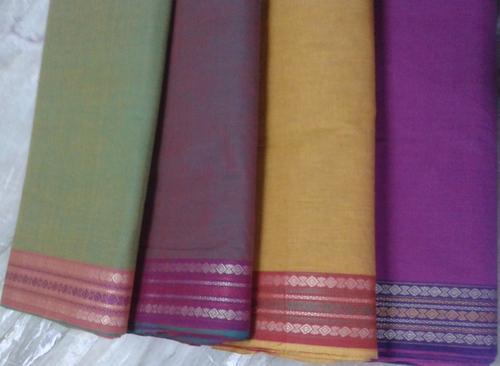Mangalagiri in Guntur District of Andhra Pradesh is famous for its special variety of saree, called Mangalagiri Saree. This saree, featuring tribal designs, is very much in demand in the fashion market. Mangalagiri sarees, woven from cotton, feature borders with closely-knit patterns embroidered with ‘zari’ (gold-colored thread). Usually these patterns are minute checks or small simple frames. The ‘pallu’ (falling edge of saree) is embellished with stripes, a typical tribal style, created with gold-colored embroidery. These sarees come in a variety of rich colors.
HISTORY OF MANGALAGIRI SAREE
Mangalagiri was always known as a pilgrim centre. There is a famed and elegant temple on a hillock in the heart of Manglagiri town dedicated to Lord Panakala Narasimha Swamy. Here, jaggery water has been offered to the lord by the devotees for several centuries. It is said in the scriptures that, the lord is being worshipped since Satya Yuga (The first of the four yugas). Below at ground level there is another temple dedicated to Lakshmi Narasimha Swamy. It is said that, Yudhishtira (Dharmaraju, the eldest of the Pandavas) installed the main deity in this temple. The temple has a very tall tower with beautiful sculpture which has 11 stairs. It was constructed by Raja Vasireddi Venkatadri Naidu, during the years 1807-09.
Local legends speak of a millennium old tradition in this region. It is said that pilgrims were expected to offer their respects to Lord Panakala Narashimha on the hill top, and then buy a saree from a local weaver before leaving the place. This clearly emphasized the patronage and impetus given to the weaving industry even as part of the tradition.
Besides, as per incormation available in South Indian Inscriptions Volume IV (published by Archaelogical Survey of India) in pages 231 to 233, t here is a clear r e ference to a Pillar inscription in the Main Bazaar street of Mangalagiri Township called the shasana Sthambam. This pillar inscription is numbered as No.711 and 711-A.
According to the inscriptions on this pillar, the muslim rulers belong to the Kutub Shahi dynasty are said to have raised the taxes on Handloom textiles during the year 1593. As t he weavers were not in a position to meet such huge taxes they left this village and migrated to other Handloom centres of the State. Thus the weaving activity in this area suffered a severe blow. Subsequently the rulers of this region pursued a more sympathetic approach towards the weavers and thus reduced the Taxes. This pillar was supposed to represent the positive attitude towards the weavers after their period of sorrow. This historical information substantiates the claim that Mangalagiri indeed had a strong weaving tradition for over 500 years.
The main occupation in the town of Mangalagiri is Hand-loom weaving. Nearly 50% of the population dependent on this cottage industry only. Because of the Hand-loom dress material produced in the town, Mangalagiri is placed in the world map.
CHARACTERISTIC AND UNIQUENESS
- pure durable cotton material
- No weave designs on body of the fabric
- Nizam border, which is peculiar only to Mangalagiri region
- Material woven only on pit-loom
- Only produced in Mangalagiri region
- No gaps on the weave in the edge of the material which is again peculiar to this kind of fabric








0 comments:
Post a Comment